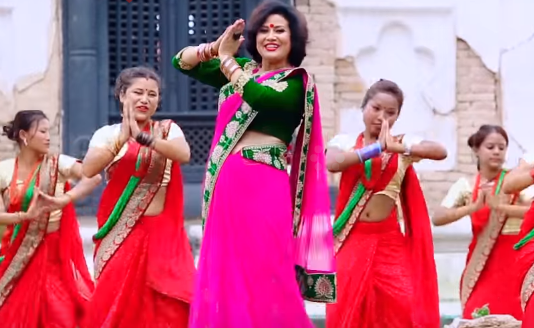Teej and Rishi Panchami
Teej is a festival celebrated by Nepali and Indian women, lets say all Hindu women for the long life of her husband and long and firm relationship between them until the death this life and all the lives to come. Teej is observed for marital happiness, well-being of spouse and children and purification of own body and soul. Teej is the most famous festival among Nepali women.
The folk music and dances add more flavor to traditional values of Teej. It is fascinating to see women, in “Red” dancing and singing on the street, going to temple in holy and fasting mood. Teej is also called Hari Talika Teej. This festival is celebrated by Nepali Hindu women all across the world.
Teej is a small red insect that comes out of the soil during the rainy season. It is said Teej got its name from the same red insect. That is why Teej is celebrated in red.
Teej this year is celebrated on 3rd day of Bhadra Sukala Paksha (according to Nepali lunar calendar). It generally falls in late August or early September. This year teej is celebrated on 16th Bhadra, 2076 BS (02 Sep, 2019). Teej is traditionally dedicated to the Goddess Parvati, remembering her union with Lord Shiva. It is a three-day-long celebration that combines splendid feasts as well as rigid fasting. Teej also welcomes and celebrates arrival of monsoon after a season of summer heat.
How do we celebrate Teej ?

The eve (first day of Teej) is called Dar Khane Din. On this day all the family members especially the women, both married and unmarried gather at one place, in their finest outfits of red (called Saubhagya) and start dancing and singing devotional songs mixed with Nepali folk and Dohori songs. This evening the grand feast takes place. The grand feast is called “Dar”. The fun often goes on till midnight, after midnight the 24-hour fasting starts.
Women who go in fasting the very next day eat a very big feast….”daro khana” (दर्हो खाना) that means a heavy food in Nepali….it is said daro khane became dar. Whatever, the meaning is, they go for big feast that evening with deserts, mithai, nepali foods like sel, puri, fruits and non vegitarian foods like mottons and chicken by some communities.
Second day is the main day of Teej (the fasting day). Some women take it very rigid, they even live without a piece of food and drops of water while some others take liquid and fruit. On this day, they happily dress in red, married women wear their lagan ko pote, nathhi, other jewelries and chadke tilahari ( jewelries are optional but chadke tilahari, laganko pote and natthi is said to be most important) and visit a nearby Lord Shiva’s temple singing and dancing all the way.
Most of devotees in Kathmandu go to Pashupatinath Temple. At the Shiva temple, women worship the Shiva lingam, the symbol of the lord Shiva, offering flowers, sweets and coins. The main puja (religious ceremony) takes place with offerings of flowers, fruits, etc., made to Shiva and Pārbati, pleading them to grant their blessing upon the husband and family. The most important part of the pooja is mostly done in the evening burning the oil lamp (108 sute batti in a diyo) which should be burning throughout the night. It is a tradition of giving the diyo of teej by her mother in law to the married woman.
Third day, women get up early in the dawn and get cleaned and do the puja once again to the diyo and goddess Parvati. The most important part of this puja is a banana and holy basil (Tulsi patta) leaf. Only after this puja, women take solid food. This third day of Teej is Ganesh Chaturthati. Women eat Karkalo ko Tarkari with chokho (pure) food made with pure ghee.

Rishi Panchami

On the fourth day, after the completion of the previous day’s pooja, women pay homage to various deities and bathe with red mud found on the roots of the sacred Datiwan bush, along with its leaves. This act of purification is the final ritual of Teej, after which women are considered forgiven from all their sins. The recent years have witnessed an adjustment in the rituals, especially regarding the strictness, but its spirit remains the same.
The actual date of inception of Teej is not known. However, it is celebrated by the women of Nepal and some part of India with lots of joy and enthusiasm. Most married women rich or poor observe this festival with fun.
Eating delicious food, popularly called dar, on the eve of Teej, and singing and dancing on the main day are the main features of this festival. On this particular day, the streets of Kathmandu turn into a sea of red with women dressed in red Sarees and Dhoties making their way to Shiva shrines, especially to the Pashupatinath Temple.
On Teej, the devotees do not eat and drink the whole day. They first offer worship to Lord Shiva and spend the rest of the day singing and dancing in the temple premises. Singing Teej songs like “Teej ko rahar aayo bari lai”. Indeed, women are seen mostly in holy sites on this day. Men are not allowed to enter the most of Shiva Temples on this day.